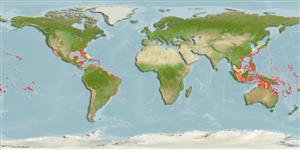Common names from other countries
Classification / Names / Names
俗名 | 同種異名 | Catalog of Fishes (gen., sp.) | ITIS | CoL | WoRMS
Environment: milieu / climate zone / depth range / distribution range
生態學
; 深度上下限 1 - 50 m (Ref. 108813).
Western Central Atlantic and Central Pacific.
Length at first maturity / 大小 / 重量 / 年齡
Maturity: Lm ? range ? - ? cm
Encrusting to massive growth form, usually with large lobate or digitate projections. External color is usually red or red-orange, but may also be yellow, dark green, greenish purple, or turquoise, internal color is always yellow-ochre. Texture is dense, flexible and rubbery but easy to tear, somewhat similar to cheese. Surface is generally smooth some with occasional goose-bumps. Spicules are straight sharply pointed tylostyles with large variation in size of about 300 to 700 micrometer. Some smaller ones have irregularly shaped or lumpy heads. Ectosome consists of brushes of smaller tylostyles of about 300 micrometers in size.
Combination depth range: min from literature, max from estimate. Occurs in mangrove ponds (Ref. 86789).
Life cycle and mating behavior
成熟度 | 繁殖 | 產卵場 | 卵 | 孕卵數 | 仔魚
Members of the class Demospongiae are hermaphroditic. Life cycle: The zygote develops into parenchymella larva (free-swimming) before settling down on a substrate where it grows into a young sponge.
主要參考資料
參考文獻 | 合作者 | 合作者
DeFelice, R.C., L.G. Eldredge and J.T. Carlton. 2001. (Ref. 3248)
IUCN 瀕危狀態 (Ref. 130435)
CITES狀態 (Ref. 108899)
Not Evaluated
Not Evaluated
對人類具威脅
人類使用
| FishSource |
工具
更多資訊
年龄/大小成長長度-重量長度-長度型態特徵仔魚豐度
網路資源
Estimates based on models
Preferred temperature
(Ref.
115969): 21.1 - 28.2, mean 26.5 (based on 566 cells).
